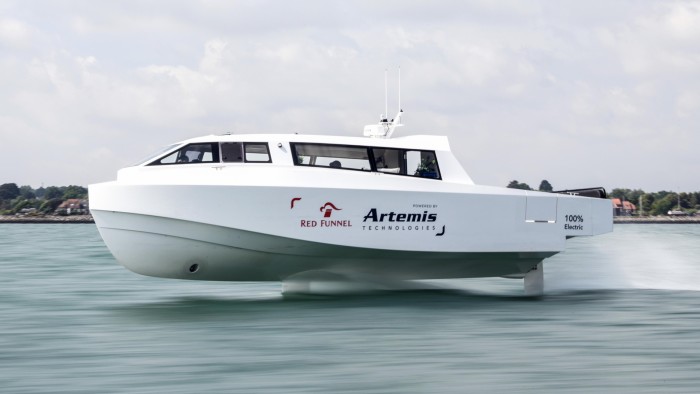Unlock the Editor’s Digest for free
Roula Khalaf, Editor of the FT, selects her favourite stories in this weekly newsletter.
In 2000, the fresh-faced British sailor Iain Percy crushed the competition in Sydney Harbour to win the first of two Olympic gold medals. He went on to manage the Artemis Racing team, skimming over the water in the America’s Cup in yachts that have been described as the Formula 1 cars of the seas.
Twenty-five years after that first triumph, Percy — now 49 and sporting an increasingly salty beard — is entering a new race involving lower speeds and rather more utilitarian vessels: passenger ferries.
I meet him at a fancy sailing club at Cowes on the northern tip of the Isle of Wight, where ferries have provided an umbilical link to the south coast of England for more than 200 years. First they were coal-fired paddle steamers. Then came the diesel age. Today Percy is showing off his all-electric Artemis EF-12 water taxi, a sleek demonstration vessel for the bigger, 150-passenger boat that will join the fleet next year at Red Funnel, a ferry company founded here in 1861.
His boats’ secret weapons lie beneath the waves. When it hits about 14 knots (25kph), a wing-like hydrofoil that houses the propeller lifts the EF-12’s hull out of the water. During one of several demo rides Red Funnel has put on for its launch, I’m struck by how the boat glides across the water as steadily as a jetliner. Unruffled by the chop as we cruise at 25 knots, it is almost silent.
“We work very hard to make it that boring,” Percy says when I tell him I barely realised I was at sea. The sailor, who grew up in Southampton, where Red Funnel is based, set up Artemis Technologies in 2017 after becoming frustrated with the glacial place of decarbonisation in the maritime world. “I’d be sailing in the America’s Cup in the beautiful waters in Bermuda, thinking our industry is so polluting when advances in technology should be making opportunities to do better,” he adds.

It took years to turn a mission into a product, but in the past 12 months Artemis has delivered 10 EF-12s for use as workboats and pilot vessels for ports. Three ferries are under construction, including the one Red Funnel will operate alongside its diesel passenger catamarans (it also runs car ferries in competition with Wightlink, the island’s other big ferry operator).
Percy has competition; new electric ferries run in Hong Kong, Dubai and Stockholm. Incat, an Australian boatbuilder, is working on the world’s biggest electric ferry, which will carry more than 2,000 passengers and their cars between Argentina and Uruguay.
Percy says electric power is ideal for short, frequent trips. Top-up charging during passenger changeovers, as well as full charges overnight, mean they can operate all day, reducing the weight and space demands of batteries. Foiling radically increases efficiency by reducing drag — and the need for sick bags. “It’s the foiling that makes this viable,” Percy adds.
After more than 20 years in elite sport, the sailor is also getting a taste of the sometimes fraught economics and politics of ferry operations. On my demonstration ride I sit next to Richard Quigley, one of the Isle of Wight’s two MPs. He tells me his inbox hums with complaints about the island’s mainland links, from mechanical failures to high prices and reduced timetables. “If this boat addresses any of that, then it’s more than welcome,” he says.

Red Funnel has survived many storms in its 164-year history, but its electric adventure comes at a turbulent time as it desperately seeks new investment. “We’re a lifeline service, so we’re always going to be under scrutiny,” Fran Collins, the company’s chief executive, tells me. She says average annual occupancy rates are just 27 per cent on its passenger ferries and 47 per cent on vehicle ferries. “That gives you a flavour of the number of unprofitable sailings we operate, but we treat this as a social licence . . . the island wouldn’t survive without it.”
Collins says upfront costs for the new ferry, which is worth about £12mn, will be spread out and that electrification will ultimately save millions in fuel costs while helping the company hit emissions targets. She pushes back at the suggestion that the Artemis partnership is more about marketing at a time when Red Funnel is courting investors. “We wanted to do this because it shows it’s real,” she says. “This is the future.”
Percy now employs about 180 people at Artemis — 30 more heads than he commanded in his America’s Cup days. Does he miss the cut and thrust of racing yachts? “I miss elements of it for sure, but in a way I find this more rewarding,” he says as the EF-12 takes its last serene tour of the Solent. “The thing I always liked was being part of a team trying to do something worthwhile.”
Find out about our latest stories first — follow FT Weekend on Instagram and X, and sign up to receive the FT Weekend newsletter every Saturday morning
